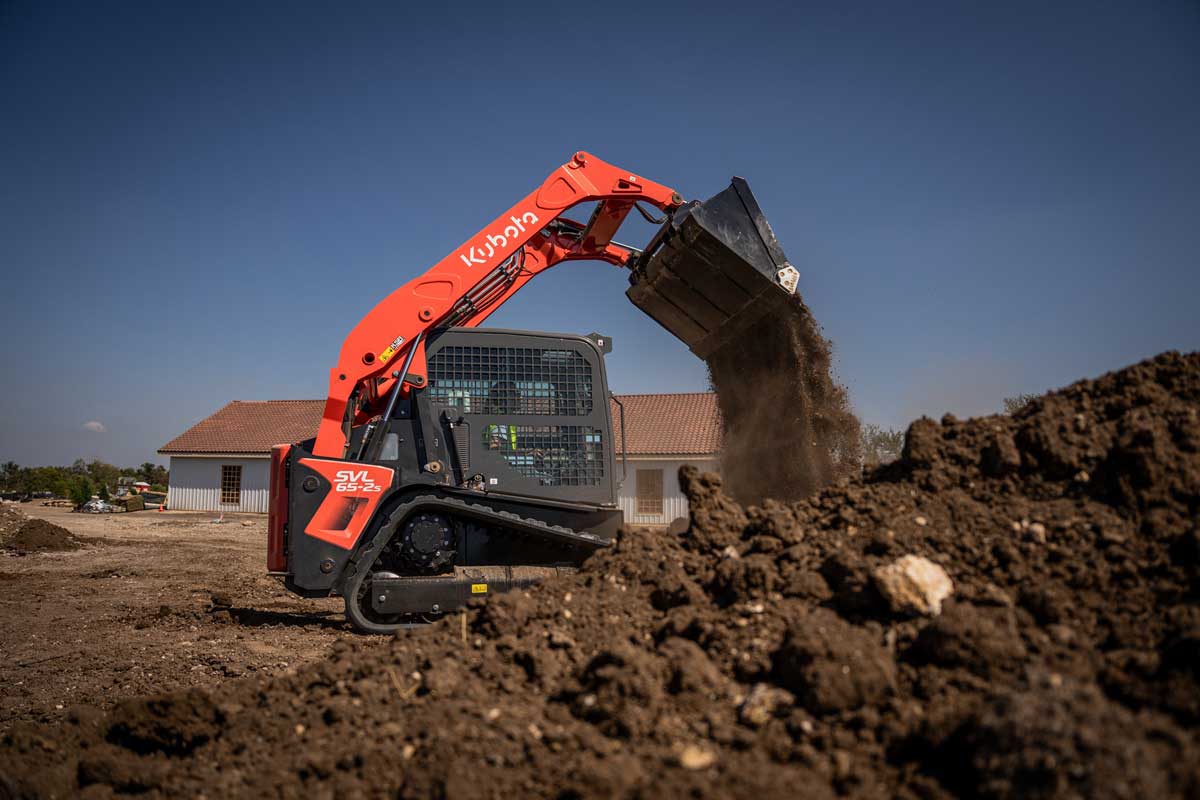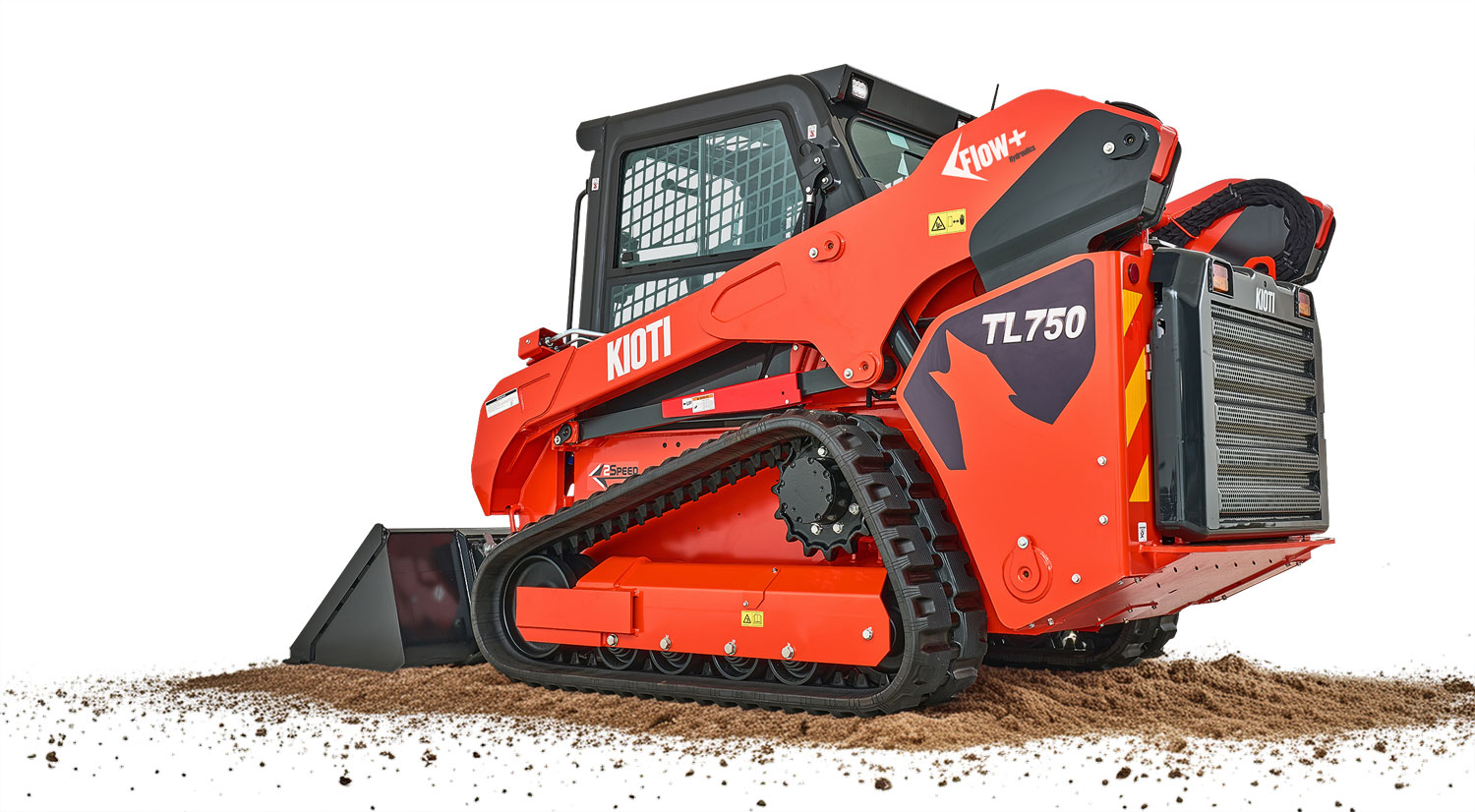JCB 2TS-7T and 215T Deep Dive: Small Compact Track Loaders with Big Capability

When it comes to compact track loaders, smaller doesn’t mean less capable — especially in JCB’s lineup. The manufacturer’s small-frame CTLs combine power, reach and operator-focused design in machines built for productivity on the tightest jobsites. From the industry-first 2TS-7T Teleskid with its telescopic boom to the compact-yet-mighty 215T, JCB engineers have redefined what a small CTL can do. In this Q&A, Lee Tice, product manager at JCB, walks us through its smallest compact track loaders — highlighting specs, standout technologies and design advantages — and explains how these nimble machines are helping contractors, landscapers and owner-operators get more done with less.
Compact Equipment: First off, thanks so much for taking the time to talk to us, Lee. You’re one of our favorite interviewees. Can we start off by summarizing your smallest compact track loaders offered today? Maybe share the major features, specs, technologies and options associated with these machines. Also, what unique features can be found on these units?
Tice: JCB’s smallest compact track loaders pack serious capability into a nimble footprint — none more so than the 2TS-7T Teleskid, the industry’s only small-platform CTL with a telescopic boom. With a rated operating capacity of 2,096 lbs and a standard 74-hp engine, the 2TS-7T pairs compact size with performance that punches above its weight. But what truly sets it apart is its telescopic boom, giving operators up to 12 ft of lift height, 7 ft of forward reach and the ability to dig below grade, all from a compact track loader platform. It’s a design that replaces the need for multiple machines on tight jobsites, letting owner-operators do more with less equipment.
The 215T, JCB’s smallest conventional compact track loader, offers a 2,105-lb operating capacity with a similar 74-hp JCB ECOMAX engine. Both models feature JCB’s exclusive single-arm boom design, engineered with more steel than twin-arm systems for strength and durability, while dramatically improving side-to-side visibility. Every JCB CTL — including the 2TS and 215T — comes with a side-door entry, eliminating the need to climb over attachments or crawl under a raised boom. That’s a big win for safety and operator convenience, especially in tight spaces.
Operators also benefit from a spacious cab, standard ergonomic servo controls and advanced options like hydraulic quick hitches, LED lighting packages and the JCB myCHOICE software for customizable control settings. The standard 18.5 gpm hydraulic flow at 3,335 psi on the 215T means both models can run a broad range of attachments, from trenchers to sweepers and augers. These aren’t just compact machines — they’re versatile tool carriers built to maximize jobsite productivity and minimize downtime.
What are the advantages of a smaller compact track loader vs. a bigger unit? Cheaper price? Easier to transport? Fits into more spaces? What are some disadvantages?
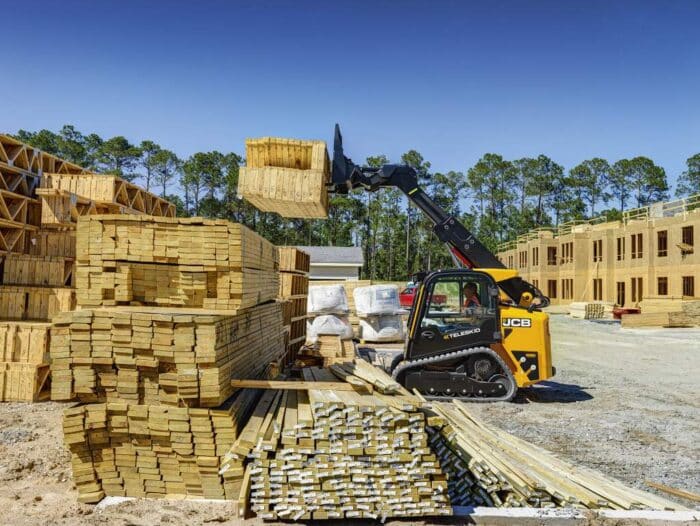
A smaller compact track loader brings a unique set of advantages, especially for owner-operators, landscapers and contractors working in confined spaces. Machines like the JCB 2TS-7T and 215T are built for maximum maneuverability. Their compact footprint allows access to areas larger CTLs simply cannot reach. That might mean working between tightly spaced homes on a residential infill project, clearing brush in a backyard with limited access or performing interior demolition in a commercial building where doorway clearance is a factor.
Transport is another key advantage. Smaller CTLs often weigh less and have a lower overall height, making them easier and more cost-effective to haul. They typically fit on standard equipment trailers, reducing the need for heavy-duty trucks or special permits. For example, a landscape contractor moving between several residential projects in a single day can haul a 2TS-7T behind a standard pickup. That maximizes jobsite flexibility and cuts down on transport costs.
Cost is also a critical factor. Smaller units usually come with a lower purchase price and cost less to operate. They burn less fuel, experience less undercarriage wear and have simpler maintenance requirements. A contractor running a 215T for utility trenching, grading and site cleanup benefits from both a lower upfront investment and reduced operating costs over time, all without sacrificing performance on typical jobsite tasks.
Of course, smaller CTLs have limitations. Their rated operating capacities are naturally lower, around 2,100 lbs for both the 2TS-7T and 215T. That is plenty for loading landscaping materials, transporting pallets of sod or gravel or handling debris removal. But if the job calls for moving large concrete blocks, heavy pipe or high-volume dirt loading, a larger-frame CTL like the JCB 270T may be a better choice. Reach and lift height are also important considerations. While a typical small CTL may offer less vertical reach than a larger unit, the 2TS-7T’s telescopic boom helps bridge that gap. It allows an operator to load material over high-sided trucks or place pallets over a fence line, tasks that most small-frame CTLs cannot perform.
Hydraulic capacity is another factor. With standard-flow hydraulics rated at 18.5 gpm at 3,335 psi, machines like the 215T are ideal for attachments such as trenchers, augers, brooms and grapples. However, they are not intended for high-flow-demand attachments like heavy-duty mulchers or large cold planers. At the end of the day, it comes down to matching the machine to the work. If the job requires nimble maneuvering, easy transport and versatility for a wide range of attachments, smaller CTLs deliver excellent value. Whether it is a landscaper installing hardscaping in a tight backyard, a contractor trenching utilities on a narrow lot or a demolition crew clearing debris inside a building, small CTLs like the 2TS-7T and 215T can get the job done efficiently and cost-effectively.
Where do these super small CTLs end up working? What types of applications are popular for the smallest subcompact track loaders?
Super small compact track loaders, like the JCB 2TS-7T and 215T, thrive in environments where space is limited but performance still matters. These machines often end up on jobsites that larger equipment simply cannot access — tight urban infill projects, residential landscaping, interior demolition and utility installations in confined spaces. Landscaping is a prime example. Contractors working in backyards, around established structures or on hardscape installations need a machine that can maneuver easily without damaging turf or delicate surfaces. The 2TS-7T’s telescopic boom is especially useful in this setting, allowing operators to place materials over fences or reach into areas where other machines cannot go, reducing manual labor and increasing jobsite efficiency.
In utility work, smaller CTLs are a common sight on jobs that require trenching, backfilling or light excavation along roadways or in narrow easements. The 215T’s compact footprint and rated operating capacity make it ideal for handling spoil removal or materials delivery in those restricted spaces. Interior demolition is another growing application. Contractors use small CTLs like the 2TS-7T inside large commercial or industrial buildings for material removal and site prep. The combination of compact size, low ground pressure and side-door entry makes them safe and practical for indoor environments where larger machines would be too cumbersome.
On construction sites, these smaller models often serve as support machines, handling cleanup, material movement or precision grading. The ability to transport them easily between jobs adds to their appeal, especially for rental operations and contractors with multiple short-term projects. Whether it is placing landscape materials in a tight backyard, trenching alongside utilities or hauling debris out of a demolition site, super small compact track loaders offer a level of access, versatility and cost-efficiency that larger machines cannot match. They are the go-to solution when space, transport and maneuverability are at a premium but serious work still needs to get done.
Let’s take a look at the smallest mini excavators on the market.
What is the auxiliary flow to attachments? Both flow and pressure? Is high flow available? What types of attachments do contractors often gravitate towards with these smaller units?
Both the JCB 2TS-7T and 215T come equipped with standard-flow hydraulics rated at 18.5 gpm at 3,335 psi. This hydraulic performance is well-suited for a broad range of everyday attachments commonly used on compact track loaders. High-flow hydraulics are not available on these smaller models. However, the standard flow is more than capable of running core attachments that contractors depend on for daily work. Common tools include trenchers, augers, pallet forks, grapples, brooms and general-purpose buckets. These attachments take full advantage of the machines’ compact size and maneuverability on busy jobsites or in tight work areas.
The 2TS-7T’s telescopic boom adds even more flexibility for material handling attachments. Contractors often use it with pallet forks or buckets to load materials, place items over obstacles or access confined areas that would normally require a larger machine or a telehandler. In utility and site prep work, trenchers and augers are frequent choices for digging, boring and trenching in areas where larger equipment cannot operate. On landscaping and construction sites, sweepers and brooms are used for cleanup tasks, while grapples are common for brush clearing, debris handling and demolition projects.
Although these smaller compact track loaders are not built for high-flow, high-demand attachments such as forestry mulchers or large cold planers, they deliver reliable hydraulic power for the vast majority of common applications. For most owner-operators and contractors, the combination of standard-flow hydraulics, versatile attachment compatibility and compact machine size makes these models a smart, cost-effective choice on the jobsite.
How much do these smaller units often cost? You don’t have to give us exact pricing (but you can!). You can also give us a range.

Pricing for smaller compact track loaders like the JCB 2TS-7T and 215T varies depending on options, attachments and regional factors, but most units fall in the range of $60,000 to $75,000. The 2TS-7T, with its telescopic boom and unique reach capabilities, generally sits toward the higher end of that range. Contractors and owner-operators see the added value in its ability to replace multiple machines on a jobsite. The 215T typically comes in closer to the $60,000 mark, offering a strong balance of performance, versatility and cost without the added investment of a telescopic boom. Final price depends on build specifications, auxiliary hydraulics, cab options, track type and selected attachments. While the investment is significant, many buyers find that the versatility, transportability and lower operating costs of these small-frame CTLs make them a high-value addition to their fleet.
How many small compact track loaders are sold each year? Is this a niche product? What percentage of sales goes to these super small CTLs?
Small compact track loaders represent a strong and steady segment of the overall CTL market, especially among owner-operators, landscapers and contractors focused on specialized or tight-access applications. While exact industrywide numbers can vary by region, small-frame models like the JCB 2TS-7T and 215T typically make up around 15 to 20 percent of total compact track loader sales in North America. It is a niche, but it is a meaningful one. The demand comes from buyers who need maneuverability, ease of transport and versatility without stepping up to a larger, more expensive machine. Contractors often view these machines as jobsite problem-solvers, especially when a larger unit is either impractical or cost-prohibitive.
At JCB, these models consistently perform well within the compact track loader lineup. The 2TS-7T in particular attracts interest from contractors who value its telescopic capability and versatility across multiple applications. While small CTLs may not be the highest-volume sellers in the category, their role in the market remains important as a flexible, cost-effective option for a wide range of industries.
What operational tips can you share when using smaller compact track loaders? Should contractors approach using these smaller track loaders differently? Are they easier to operate? Harder?
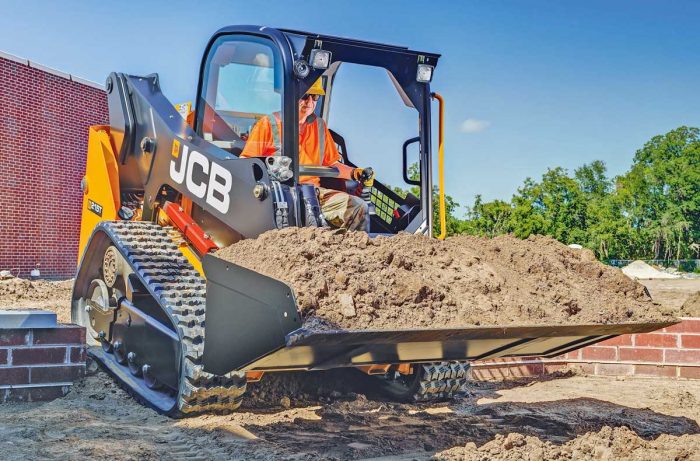
Operating a smaller compact track loader is not drastically different from running a larger model, but there are a few key considerations that can make a big difference in safety, efficiency and long-term performance. It starts with matching the machine’s capabilities to the job at hand. One of the most common mistakes contractors make is assuming a smaller machine will perform like a larger one in every application. While compact models like the JCB 2TS-7T and 215T offer impressive lifting capacity and attachment versatility, they are still limited by their rated operating capacity and hydraulic output. Overloading the machine, pushing it beyond its intended duty cycle or pairing it with undersized attachments can lead to performance issues, increased wear and even safety risks.
The right approach is to focus on the machine’s strengths — maneuverability, transportability and versatility in tight spaces. Smaller CTLs are ideal for jobsites where access is restricted or surface damage needs to be minimized. For example, using a 2TS-7T with a pallet fork to place materials over a fence line or into a tight corner maximizes both the machine’s reach and its productivity without overextending its capacity. Visibility is another operational advantage with smaller JCB models. Both the 2TS-7T and 215T feature JCB’s single-arm boom design, which provides better side-to-side visibility compared to twin-arm machines. This enhanced visibility helps operators work more confidently around people, obstacles and other equipment. Pair that with the side-door entry, which eliminates the need to climb over attachments or crawl under a raised boom, and you have a machine designed with both safety and ease of operation in mind.
Ease of operation is often better on smaller units, especially for less experienced operators. The machines are more nimble, easier to position and less intimidating to control. Features like JCB’s ergonomic servo controls and spacious cabs further improve operator comfort and control. That translates to better performance over long shifts and reduces fatigue-related mistakes on the jobsite. From an efficiency standpoint, daily maintenance and service checks are just as important on smaller CTLs as they are on larger ones. Taking advantage of features like ground-level service access and simplified hydraulic routing can help crews stay on top of preventative maintenance, reducing downtime and extending machine life.
Contractors should also be mindful of ground conditions and traction. While smaller CTLs have excellent flotation and ground pressure ratings, they are still susceptible to soft ground or loose material, especially when fully loaded. Proper weight distribution, careful operation on slopes and an understanding of the machine’s limits are key to maintaining safe and efficient performance. In short, smaller compact track loaders offer a lot of advantages, but they perform best when operators understand and respect their capabilities. Matching the right machine to the right job, staying proactive with maintenance, and taking full advantage of safety and visibility features all help maximize the value and performance of these compact machines on any jobsite.
What advice would you give a contractor looking to buy or rent a smaller compact track loader?
One piece of advice contractors may not always consider when choosing a smaller compact track loader is how the machine fits into their transport routine and overall fleet logistics. Moving equipment between jobsites is a daily part of most operations, and the size, weight and transport requirements of a machine can have a big impact on both cost and efficiency. A compact track loader that fits on a standard equipment trailer and can be hauled with the trucks you already own may eliminate the need for special permits, CDL drivers or heavy-duty hauling equipment. That translates into fewer headaches, lower transportation costs and less downtime shuffling equipment between jobs. It also gives contractors the flexibility to respond quickly to changing project demands without relying on specialized transport or additional crew.
Choosing a machine with transportability in mind is more than a convenience. It can streamline daily operations and improve profitability over time. Whether it is a landscaper moving between residential jobs or a contractor hauling equipment from a staging yard to a city worksite, having a machine that fits your existing fleet setup makes a real difference in productivity. The right compact track loader should not only meet your jobsite needs but also fit seamlessly into your transportation and fleet management plans.
What trends do you see in the compact track loader market overall? Are buyers gravitating toward certain sizes or technologies? Are there certain regions where sales are increasing or decreasing? What interesting evolutions do you see in the market and the near future?
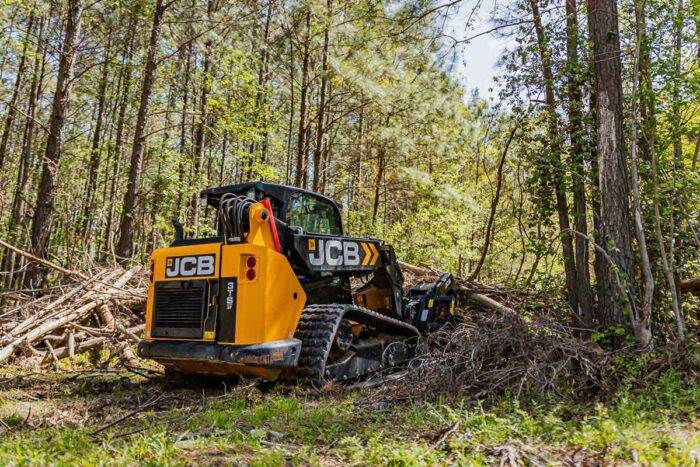
The compact track loader market has seen steady evolution over the past several years, with a few clear trends shaping buyer behavior and equipment design. One of the most significant shifts is the growing demand for versatility across all machine sizes. Contractors want equipment that can handle multiple roles on the jobsite, and compact track loaders are increasingly viewed as multipurpose tool carriers rather than single-application machines. This has driven interest in models that offer a balance of lifting capacity, maneuverability and attachment compatibility, whether in small-frame units or larger platforms.
Technology is another area where the market continues to advance. Buyers are gravitating toward machines with enhanced operator comfort, advanced hydraulics and smarter control systems. Features like joystick customization, telematics, advanced diagnostics and improved visibility are no longer reserved for premium models. Even in smaller CTLs, contractors expect user-friendly controls, real-time machine data and ergonomic designs that reduce operator fatigue over long shifts. Regionally, demand for compact track loaders remains strong in areas with soft ground conditions, such as the Southeast and Midwest, where tracks offer superior flotation and traction. Urban areas and residential markets are also driving demand for smaller models that offer easy transport and maneuverability in confined spaces. At the same time, contractors in regions with hard ground or heavy construction activity continue to favor larger CTLs for their lift capacity and durability.
Looking ahead, the market is trending toward more compact, versatile machines with advanced operator aids and connectivity. There is also growing interest in machine designs that prioritize operator safety and simplify service access — features like better visibility, easier cab access and streamlined maintenance routines. These changes reflect a broader shift in the industry toward machines that help contractors improve efficiency, manage operating costs and adapt to a wide variety of jobsite demands. The next evolution will likely include smarter attachments, further integration of telematics and even more emphasis on operator experience. As jobsites become more complex and margins stay tight, contractors are looking for compact equipment that can deliver high performance, flexibility and lower total cost of ownership. Compact track loaders are well-positioned to meet that demand, making them a key part of the equipment landscape for the foreseeable future.
Lee, awesome info. We really appreciate you taking the time to talk to us. Is there anything else you’d like to mention? Anything else we’re missing here?
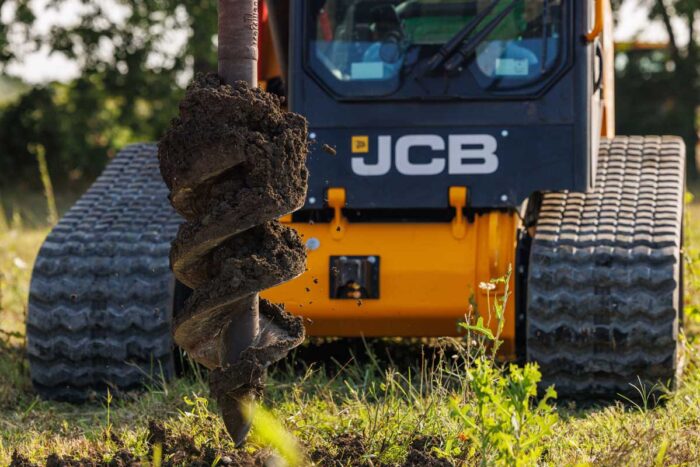
On a final note, it is important for contractors to look beyond the purchase price when evaluating a compact track loader. Long-term return on investment comes from more than just initial cost. Resale value, dealer support and brand reputation all play critical roles in protecting that investment over time. A machine that holds its value in the used market, such as JCB compact track loaders known for their durability and unique features, can help offset the initial expense when it comes time to upgrade or rotate fleet equipment. Dealer support is equally important. JCB’s growing North American dealer network provides access to timely service, parts availability and expert support. This helps keep machines running and jobs on schedule. Strong relationships with a dependable dealer often make the difference between a quick fix and extended downtime.
Contractors should also consider where and how their equipment is built. JCB manufactures its compact track loaders for the North American market in Savannah, Georgia, ensuring the machines are designed to meet regional needs with local support and fast parts access. In the end, a compact track loader is more than a purchase. It is a key part of the business. With JCB, contractors gain a machine designed for long-term performance, backed by a commitment to service, resale value and dependable support that continues long after the initial sale.
Keith Gribbins is publisher of Compact Equipment.
Find out more about some of the largest skid steers on the market.

